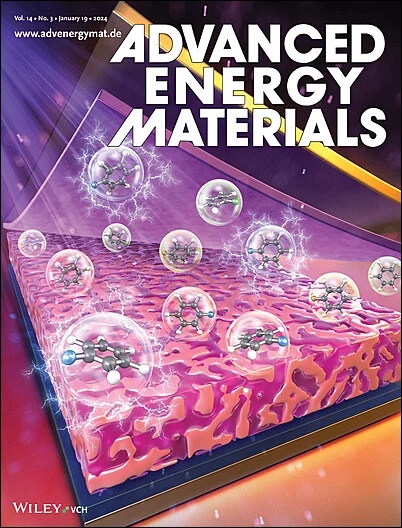光增强硫离子电氧化耦合亚硝酸盐电还原的富缺陷AuCu/ cu纳米线异质结
IF 26
1区 材料科学
Q1 CHEMISTRY, PHYSICAL
引用次数: 0
摘要
亚硝酸盐电还原反应(NO2ERR)为氨(NH3)的合成和亚硝酸盐污染物的修复提供了一条有前景的途径。铜基纳米材料已经显示出作为NO2ERR催化剂的巨大潜力,但其催化活性和耐久性受到加氢过程的限制。在这项工作中,采用合金化和后硫化策略合成了AuCu/ cu纳米线(NWs),该纳米线具有丰富的非晶活性位点和独特的电子结构。AuCu/ cu NWs对NO2ERR均表现出较高的电活性(法拉第效率:95.26%;NH3产率:2.54 mg h−1 gcat−1)和硫离子电氧化反应(SEOR,氧化电位:−0.05 V, 10 mA cm−2)。原位表征和理论计算解释了无定形cu可以修饰AuCu合金的电子性能,从而优化了活性氢和含氮中间体的吸附。以AuCu/ cu NWs为双功能电催化剂,组装的NO2ERR||SEOR双电极体系仅需0.77 V的电解电压即可获得10 mA cm−2的电流密度,并伴有硫和NH3的协同生产。光照条件下,NO2ERR||SEOR双电极体系的电解电压进一步降低。本研究提供了一种通过NO2ERR与SEOR相结合实现附加值产品共产的新方法。本文章由计算机程序翻译,如有差异,请以英文原文为准。

Defect‐Rich AuCu/CuS Nanowires Heterojunction for Light‐Enhanced Sulfur Ion Electrooxidation Coupled Nitrite Electroreduction
The nitrite electroreduction reaction (NO2 ERR) offers a promising pathway for ammonia (NH3 ) synthesis and the remediation of nitrite pollutants. Copper (Cu)‐based nanomaterials have demonstrated significant potential as NO2 ERR catalysts, but their catalytic activity and durability are hindered by limitations in the hydrogenation process. In this work, alloying and post‐sulfurization strategies are employed to synthesize AuCu/CuS nanowires (NWs), which feature abundant amorphous active sites and distinct electronic structures. AuCu/CuS NWs exhibit high electroactivity for both NO2 ERR (Faradaic efficiency: 95.26%; NH3 yield: 2.54 mg h−1 gcat −1 ) and sulfur ion electrooxidation reaction (SEOR, oxidation potential: −0.05 V at 10 mA cm−2 ). In situ characterization and theoretical calculations explain that amorphous CuS can modify the electronic property of AuCu alloy, thereby optimizing the adsorption of active hydrogen and nitrogen‐containing intermediates. Using AuCu/CuS NWs as a bifunctional electrocatalyst, the assembled NO2 ERR||SEOR two‐electrode system only requires the electrolysis voltage of 0.77 V to obtain the current density of 10 mA cm−2 , accompanied by the co‐production of sulfur and NH3 . Under light irradiation conditions, the electrolysis voltage of the NO2 ERR||SEOR two‐electrode system is further reduced under light irradiation conditions. This study offers a novel approach for the co‐generation of value‐added products through NO2 ERR coupled with SEOR.
求助全文
通过发布文献求助,成功后即可免费获取论文全文。
去求助
来源期刊

Advanced Energy Materials
CHEMISTRY, PHYSICAL-ENERGY & FUELS
CiteScore
41.90
自引率
4.00%
发文量
889
审稿时长
1.4 months
期刊介绍:
Established in 2011, Advanced Energy Materials is an international, interdisciplinary, English-language journal that focuses on materials used in energy harvesting, conversion, and storage. It is regarded as a top-quality journal alongside Advanced Materials, Advanced Functional Materials, and Small.
With a 2022 Impact Factor of 27.8, Advanced Energy Materials is considered a prime source for the best energy-related research. The journal covers a wide range of topics in energy-related research, including organic and inorganic photovoltaics, batteries and supercapacitors, fuel cells, hydrogen generation and storage, thermoelectrics, water splitting and photocatalysis, solar fuels and thermosolar power, magnetocalorics, and piezoelectronics.
The readership of Advanced Energy Materials includes materials scientists, chemists, physicists, and engineers in both academia and industry. The journal is indexed in various databases and collections, such as Advanced Technologies & Aerospace Database, FIZ Karlsruhe, INSPEC (IET), Science Citation Index Expanded, Technology Collection, and Web of Science, among others.
 求助内容:
求助内容: 应助结果提醒方式:
应助结果提醒方式:


